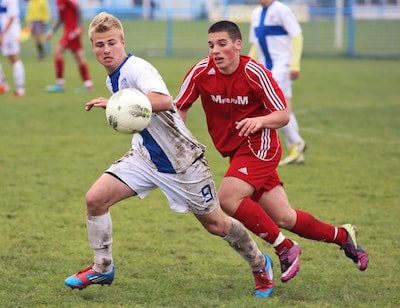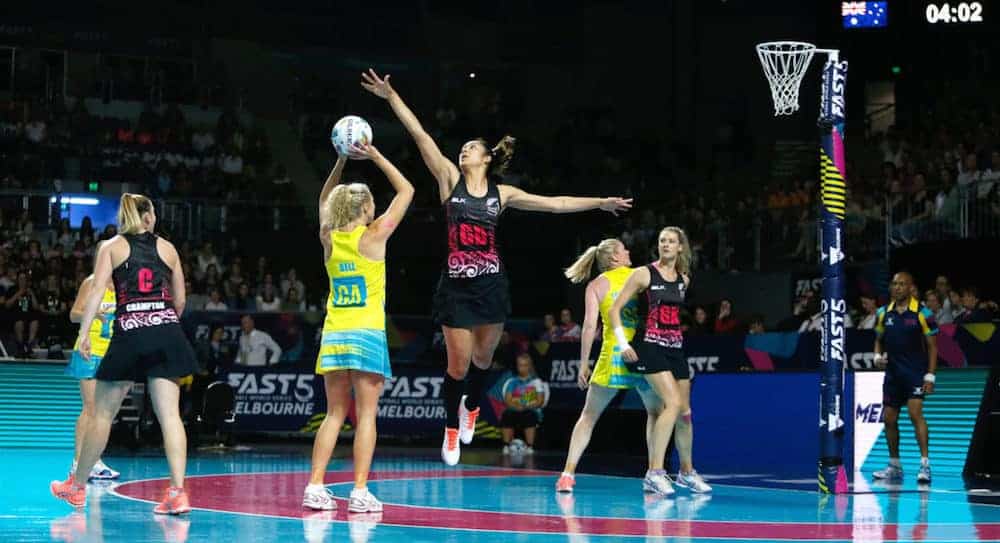
Blog, Kids Feet

Knee pain in kids
“Knee pain almost exclusively only affects active kids,” says sports podiatrist and founder of A Step Ahead Foot + Ankle Care Dr Brenden Brown.
“In the majority of cases the knee pain will be related to a specific period of activity.
“Sometimes you have to look back 12 hours before the pain starts to pinpoint the activity that caused it. For example, a child might be sore and suffering from a really painful knee on Sunday yet because they didn’t hobble off the footy field after their game on Saturday the parents don’t relate the pain to playing football.”
Causes of kids’ knee pain
Dr Brenden says knee pain in children is predominantly caused by Osgood-Schlatter disease.

What is Osgood-Schlatter disease?
Osgood-Schlatter disease is characterised by a painful lump just below the kneecap.
According to the American Academy of Orthopaedic Surgeons, ‘Osgood-Schlatter disease most often occurs during growth spurts, when bones, muscles, tendons, and other structures are changing rapidly. Because physical activity puts additional stress on bones and muscles, children who participate in athletics—especially running and jumping sports—are at an increased risk for this condition. However, less active adolescents may also experience this problem.’
Treating knee pain in kids
“The most common treatment approach by practitioners is stretching or advising the child to stop playing sport.
“I disagree,” says Dr Brenden.
“Telling kids to stop playing sport is not a treatment modality. It’s simply avoiding the cause of the pain. Once they start activity again, BOOM the pain re-appears!
“Similarly, stretching alone will not, in most cases, cure the underlying problem. I see children who are given stretching routines by their healthcare professionals time and time again, season after season. If knee pain is an ongoing problem for the child, we should be evaluating their foot posture in order to find the core problem and a positive long-term solution.”
Dr Brenden adds, “There are far too many viable treatment options available which can address the underlying issue of knee pain and keep children active.
“Advising a child to stop playing sport is no longer necessary and is in fact detrimental to child’s long-term health”

Tips to prevent knee pain in kids
—Warm up properly. Before you “warm up” with a jog, try walking at a moderate to brisk pace 4 times around the football field (8 times around a netball court). Start slow, increase as you progress—NEVER run!
—Ensuring you’re wearing the right footwear can help protect the knees. Wear good, supportive, sports-specific shoes (not the trendiest runners you can find!).
“Choosing appropriate footwear that’s specific to the sport being played would likely reduce the amount of foot-related injuries we see by at least 25%,” says Dr Brenden.
—Work on improving the leg muscle strength and flexibility. Isometric strength exercises are readily accessible and can be performed anywhere—even when in pain!
Related articles:
Warming up for sports…why bother?
What’s causing your child’s heel pain?
Common kids’ foot complaints
ABOUT US
A Step Ahead Foot + Ankle Care is one of Sydney’s leading foot and ankle clinics. Principal podiatrist and founder of A Step Ahead Dr Brenden Brown (AKA Dr Foot) has been taking care of people’s feet for more than 20 years.
With a background in sports medicine and having served as a former president of the Australasian Podiatry Council, Brenden is a wealth of information when it comes to foot and ankle care.

Blog, Heel Pain, Sports Care

Isotonic versus isometric movements for heel pain
“It’s becoming much more widely recognised and accepted that stretching is not good for tendon pain. Instead, we should be looking at building muscle and tendon strength,” says sports podiatrist and founder of A Step Ahead Foot + Ankle Care Dr Brenden Brown.
Professor Jill Cook, from La Trobe University’s Sport and Exercise Medicine Research Centre, has a wealth on knowledge about tendon injury. She says, “Aside from the load on your tendon when you play sport, there are compressive loads on your tendon when it is at its longest length, adding stretching to most tendons only serves to add compressive loads that we know are detrimental to the tendon. Stretching while you are standing can be especially provocative to your tendon.”
Isotonic Vs isometric
Isotonic contractions generate force by changing the length of the muscle and tendon
[For example, going up and down on your toes (calf raise)]
Isometric contractions generate force without changing the length of the muscle or tendon.
[For example, going up on your toes and holding in the upward position]
“People are familiar with isotonic exercises, particularly for the pain associated with Achilles Tendinopathy. There was a well know technique called the ‘Alfredson technique’, in which people would stand on edge of a step and lower their heels up and down over the back of step.
“This has long been therapists’ go-to exercise, for heel pain in particular. However, we now know this only serves to irritate and aggravate this condition, yet it doesn’t have to be so,” says Dr Brenden.
“We need to graduate the building of strength and to do this we start with isometric movements, rather than rushing straight into isotonic movements.”
Isotonic versus isometric movements for heel pain
For the majority of people the process involves moving from isometric holds with quite heavy loads of body weight or beyond.
After we’ve developed significant load and reduced the symptoms, including pain, we begin to move into the next phase, which includes isotonic movements.
From there we move to more functional strength exercises that are specific to your activity or sport.
This means the exercises can’t just be calf raises, they need to be aligned to the individuals activity so that their tendon is ready for the activity they’re about to re-enter into.
“I like to refer to isometric loading as ‘progressive muscle loading’. Gradual loading is such a vital part; if people are not progressing they won’t get back healthy strong tendons,” says Dr Brenden.
Common mistakes people make when performing isometric exercises
- They don’t loading heavy enough. Remember, tendons are built for strength so they can take quite a bit of weight.
- They don’t load for long enough
- They don’t progress. Instead they plateau out. At all times, on a day-to-day basis moving through to a week-to-week basis you should be progressively increasing time and load to develop the tendon’s and muscle’s strength and capacity.
Related articles:
Warming up for sports—why bother?
10 things you should know about heel pain
A Step Ahead Foot + Ankle Care is one of Sydney’s leading foot and ankle clinics. Principal podiatrist and founder of A Step Ahead Dr Brenden Brown (AKA Dr Foot) has been taking care of people’s feet for more than 20 years.
With a background in sports medicine and having served as a former president of the Australasian Podiatry Council, Brenden is a wealth of information when it comes to foot and ankle care.

Blog, Sports Care

4 hacks for staying injury free this winter sports season
Regular physical activity is an essential part of living a healthy life and yet a sports injury can see you on the sideline (and in agony) for months.
Sports podiatrist and founder of A Step Ahead Foot + Ankle Care Dr Brenden Brown says there are several strategies you can take to help stay injury free during sports season.
“Grief associated with injury, particularly for children with pain related to Osgood–Schlatter and Sever’s Disease, could be greatly reduced with a few simple practices.
“We see many people significantly reduce the intensity of their discomfort and injury once they start implementing the following 4 hacks for staying injury free.”
Dr Brenden’s top tips for warding off injury
1. Focus on warming up. “WALK, before you run!”
Many kids arrive at their sports training session and their coach says, “Right, go for a run”. This is way too much sudden change for the muscles (this rings true for both adults and children).
Br Brenden advocates the ‘Two footy fields or eight netball courts’ approach…
- Start slowly walking around the outside of 2 footy fields, end-to-end or side-to-side. For court sports, this equates to approximately 8 laps of the court!
- As you walk further SLOWLY pick up the pace. “NEVER get to a run!”
- You will do 2 complete laps of the 2 fields or 8 laps of the courts.
- NOW you are ready to look at further warm up exercises and maybe that coach’s run!
2. Make sure you wear the right footwear for the activity you’re doing. Sounds simple, but the wrong footwear can result in serious damage.
“Choose the shoes that have been specifically designed for YOUR sport. This means wearing netball shoes for netball not cool minimalist runners with uber trendy logos worn by athletes from an entirely different sport!” says Dr Brenden.
3. Take a long-term approach. Yes, you can cram the night before a big exam but we all know it’s the long-term work you put in that really gets the results.
This means doing regular muscular work in order to build muscular strength for the activity you’re participating in. Doing regular muscle work over a long period of time is much more likely to stop you getting an injury, than warm ups alone.
“Don’t get me wrong; warm ups are important – but we know that to stay injury free, being strong in your activity is going to greatly reduce the likelihood of injury and so building muscular strength is key.
“For example, if you’re a netball player, glute strength is vital to reduce ankle sprains. Soccer and rugby players will benefit from working on their quad strength, while runners should focus on their sprint ability,” advises Dr Brenden.

4. Perform activity-specific warm ups and training. I often see netballers shooting hoops and running straight up and down the court in their warm-up and training sessions, but it’s far better to do side-to-side jumps, high jumps and lands, as well as cutting movements. This is much more specific to what they’ll likely to be doing on the court.
If you think about it, there are only two goal shooters on each team; if training involves the entire team standing around the netball hoop trying to shoot goals, everyone, apart from the two goal shooters, is wasting their time.
Related articles:
Warming up for sports — why bother?
Winter sports’ greatest enemy….ankle sprain
Your guide to choosing the right football boot
Your guide to choosing the best netball shoe
A Step Ahead Foot + Ankle Care is one of Sydney’s leading foot and ankle clinics. Principal podiatrist and founder of A Step Ahead Dr Brenden Brown (AKA Dr Foot) has been taking care of people’s feet for more than 20 years.
With a background in sports medicine and having served as a former president of the Australasian Podiatry Council, Brenden is a wealth of information when it comes to foot and ankle care.

Blog, Uncategorized

Ingrown toenail surgery—is it right for you?
What does ingrown toenail surgery involve?
Surgery to address an ingrown toenail (onychocryptosis) involves removing the bothersome nail and applying a chemical to prevent the nail from growing back.
In some instances it may be necessary or most beneficial to remove a small section of nail at one or both sides, but on the odd occasion the entire nail (total nail avulsion) will be removed.
It is a quick and simple procedure than is essentially pain free as it is performed with an injection of local anaesthetic.
Following surgery the toe is dressed and generally speaking there is little, if any, pain or discomfort. You may expect some throbbing that night or discomfort but this is most often managed well with paracetamol.
When is toenail surgery the best option?
Ingrown toenail surgery should not be considered first-line treatment for an ingrown toenail. It can be considered when:
- Other non-surgical methods have been exhausted
- The nail is involuted or curved
- Ingrown toenail is problematic, painful or recurring
- You understand the implications and potential complication of surgery
- You have discussed any concerns with your podiatrist
What are the advantages of clinic-based toenail surgery?
- No time in hospital
- No Sutures / stitches required – all completed under the nail plate
- No more recurrent ingrown toenails
- Pain free
- Minimal time off work
- Reduced episodes of infection and lesions (weeping, bleeding)
- In the majority of cases, ingrown toenail surgery is very successful
Dr Brenden Brown, podiatrist and founder of A Step Ahead Foot + Ankle Care, says, “Nail surgeries are not new for podiatrists; we perform them on a regular basis. It is part of our training at University so we are well versed in this surgery. It is carried out in our clinic and, due to our high level of training, is a fairly simple procedure.
“I often describe this surgery as ‘relatively pain free’. It is wrong to say any surgical procedure is ‘completely pain free’ but as procedures go our patients report very little, if any, pain. In fact, patients are frequently surprised at just how pain free it actually is!
“This procedure can certainly be of benefit and is recommended for patients who have a history of infection or recurrent ingrown toenails. It’s also very helpful for patients with involuted or very curved nails and toenails with areas that seem to catch the skin on the side of the nail.
“Patients often suffer from an ingrown toenail for many years with little idea where to go to for help.
“The days of painful surgeries with patients regularly experience nail re-growth are gone. It’s also important to remember that what you see on YouTube and other social media sites is often the ‘most horrible’ and ‘most atrocious’. If it wasn’t so gruesome you probably wouldn’t have been so motivated to watch and it likely would have got the “views” it did!
Related articles:
5 hacks to keep ingrown toenails at bay
ABOUT US
A Step Ahead Foot + Ankle Care is one of Sydney’s leading foot and ankle clinics. Principal podiatrist and founder of A Step Ahead Dr Brenden Brown (AKA Dr Foot) has been taking care of people’s feet for more than 20 years.
With a background in sports medicine and having served as a former president of the Australasian Podiatry Council, Brenden is a wealth of information when it comes to foot and ankle care.
Got a question? Check out our Instagram profile #AskDrFoot
Tune into our Facebook page for regular live videos and updates on the latest foot and ankle advice from the experts.















 Dr Brenden’s White paper report on the “6 Reasons You Won’t Beat Heal Pain” outlines what’s stopping you from beating this and tips on how to stop it in its tracks!
Dr Brenden’s White paper report on the “6 Reasons You Won’t Beat Heal Pain” outlines what’s stopping you from beating this and tips on how to stop it in its tracks!